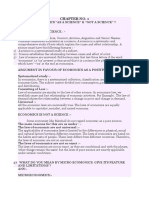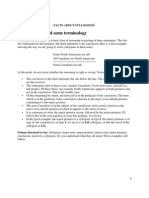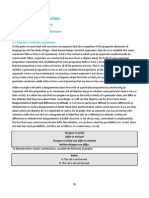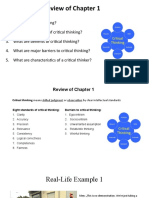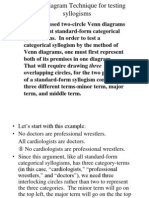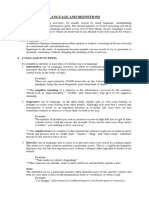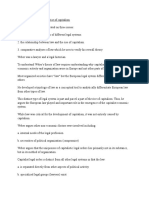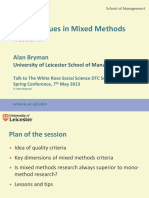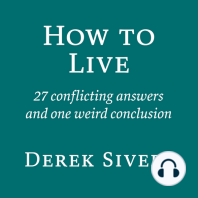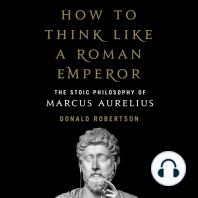-
Professional Documents
-
Culture Documents
Notes in Logic
Uploaded by
Joseph De Villa BobadillaCopyright
Available Formats
Share this document
Did you find this document useful?
Is this content inappropriate?
Report this DocumentCopyright:
Available Formats
Notes in Logic
Uploaded by
Joseph De Villa BobadillaCopyright:
Available Formats
Supplement #3
Introduction to Philosophy with Logic and Critical Thinking
Compiled by Prof. Elmer P. Brabante, LLB
NOTES ON LOGIC
Definition and Nature of Logic
Logic is the formal systematic study of the principles of valid inference and correct reasoning
(Penguin Encyclopedia). As a discipline, Logic dates back to Aristotle, who established its fundamental
place in Philosophy. It became part of the classical trivium, a fundamental part of a classical education,
and is now an integral part of disciplines such as mathematics, computer science, and linguistics. Logic is
the study of the methods and principles used to distinguish correct from incorrect reasoning. Reasons are
and coins we pay for the belief that we hold. With reasoning, we produce arguments that can be
formulated in speech or in writing.
The concept of logical form is central to logic; it being held that the validity of an argument is
determined by its logical form, bot by its content. Traditional Aristotelian syllogistic logic and modern
symbolic logic are examples of formal logics. Informal logic is the study of natural language arguments.
The study of fallacies is an especially important of informal logic. The dialogues of Plato are a good
example of informal logic. Formal logic is the study of inference with purely formal content, where that
content is made explicit. Symbolic logic is the study of symbolic abstractions that capture the formal
features of logical inference. It is divided into propositional logic and predicate logic. Mathematical logic
is an extension of symbolic logic into other areas, in particular the study of model theory, proof theory, set
theory, and recursion theory.
History of Logic
The earliest sustained work on the subject of logic is that of Aristotle. In contrast to other
traditions, Aristotelian logic became widely accepted in science and mathematics, ultimately giving rise to
the formally sophisticated systems of modern logic. Several ancient civilizations have employed intricate
systems of reasoning and asked questions about logic or propounded paradoxes. In India, the Nasadiya
Sukta of the Rigveda contains ontological speculations in terms of various logical divisions that were later
recast formally as the four circles: “A”, “not A”, “Neither A or not A”, and “Both not A and not not A”. the
Chinese philosopher Gongsun Long (325-250 BCE) proposed the paradox “One and one cannot become
two, since neither becomes two.” Also, the Chinese ‘School of Names’ is recorded as having examined
logical puzzlels such as “A White horse is not a horse” as early as the fifth century BCE.
Logic in Islamic philosophy also contributed to the development of modern logic, which included
the development of Avincennian logic as an alternative to Aristotelian logic. Avicenna’s system of logic was
responsible for the introduction of hypothetical syllogism, temporal modal logic, and inductive logic. The
rise of the Asharite School, however, limited original work on logic in Islamic philosophy, though it did
continue into the 15th century and had a significant influence on European logic during the Renaissance.
1
During the later medieval period, major efforts were made to show that Aristotle’s ideas were
compatible with Christian faith. During the later period of the Middle Ages, logic became a main focus of
philosophers, who would engage in critical logical analyses of philosophical arguments.
The syllogistic logic developed by Aristotle predominated until the mid-nineteenth century when
interest in the foundations of mathematics stimulated the development of logic (now called mathematical
logic). In 1854, George Boole published An Introduction of the Laws of Thought on Which are Founded the
Mathematical Theories of Logic and Probabilities, introducing symbolic logic and the principles of what is
now known as Boolean Logic. In 1879, Gootlob Frege inaugurated modern logic via Begriffsschrift with the
invention of quantifier notation. In 1903, Alfred North Whitehead and Bertrand Russell published Principia
Mathematica, attempting to derive mathematical truths from axioms and inference rules in symboli logic.
In 1931, Godel raised serious problems with the foundationalist program and logic ceased to focus on such
issues.
The development of logic since Frege, Russell and Wittgenstein had a profound influence on the
practice of philosophy and the perceived nature of philosophical problems, and philosophy of
mathematics. Logic, especially sentential logic, is implemented in computer logic circuits and is
fundamental to computer science. Logic is commonly taught by university philosophy departments often
as compulsory discipline.
THREE DIVISIONS OF ARGUMENT: (1) PROPOSITION
Propositions are the material of our reasoning. It asserts that something is or is not the case; any
proposition may be affirmed or denied—all propositions are either true or false. Proposition is the term
we use to refer to what it is that a declarative sentences are typically used to assert. Sentences are parts
of some language, but propositions are not tied to any given language. The four sentences – It is raining
(English); Esta llovendo (Spanish); Il pleut (French); and Es regnet (German) – are in different languages,
but they have a single meaning. All four, using very different words, may be uttered to assert the very
same proposition, or the same statement. The term statement is not an exact synonym of proposition, but
it is used in logic in much the same sense. Propositions are either simple, compound, disjunctive,
hypothetical.
Simple is a proposition that makes only one assertion. Example: The largest state in the United
States was once an independent republic. It was a true statement about Texas, but it is now a false
statement about Alaska. Those very same words assert different propositions at different times.
Compound proposition contains two or more simple propositions. Example: The British were at
the gates of Hamburg and Bremen. This sentence is composed of two simple propositions: (1) The British
were at the gates of Hamburg; and (2) The British were at the gates of Bremen.
Disjunctive or Alternative proposition is a type of compound proposition—if true, at least one of
the component propositions must be true. Example: Circuit Courts are useful, or they are not useful.
Neither of the two components is asserted; only the compound disjunction, “either-or” is asserted. If this
disjunctive proposition is true, either of its components could be false.
Hypothetical or Conditional proposition is a type of compound proposition which is false only
when the antecedent is true and the consequent is false. Example is this statement from Voltaire: If God
did not exist, it would be necessary to invent him. Neither of the components is asserted. The proposition
that “God does not exist” is not asserted; nor is the proposition that “it is necessary to invent him.” Only
the “if-then” proposition is asserted by the hypothetical or conditional statement, and that conditional
statement might be true even though both of its components were false.
2
ARGUMENT
Argument is a structured group of propositions, reflecting an inference. It is a group of
propositions of which one is claimed to follow from the others, which are regarded as providing support or
grounds for the truth of that one. For every possible inference, there is a corresponding argument.
Inference is a process of linking propositions by affirming one proposition on the basis of one or more
other propositions. Premise is a proposition used in an argument to support some other proposition.
Conclusion is the proposition in an argument that the other propositions, the premises, support.
Propositions are the building blocks of which arguments are made. When we reach or affirm one
proposition on the basis of other propositions, we say that an inference has been drawn. Some inferences
are warranted or correct, others are not. To determine whether an inference is correct, the logician
examines the propositions with which the process begins and ends, and the relations between those
propositions. This cluster of propositions constitutes an argument. Arguments are the chief concern of
logic.
For an argument to be present, there must be a structure within the cluster of propositions, a
structure that captures or exhibits some inference. We describe this structure as premise and conclusion.
The conclusion of an argument is the proposition that is affirmed on the basis of the other propositions of
the argument. Those other propositions, which are affirmed or assumed as providing support for the
conclusion, are the premises of the argument. The simplest kind of argument consists of one premise and
a conclusion that is claimed to follow from it. Premise and conclusion may be stated in separate
sentences:
No one was present when life first appeared on earth. Therefore any statement about life’s origins
should b considered as theory, not fact.
or in the same sentence:
Since it turns out that all humans are descended from a small number of African ancestors in our
recent evolutionary past, believing in profound differences between the races is as ridiculous as
believing in a flat earth.
Although every argument is a structured cluster of propositions, not every structured cluster of
propositions is an argument. Not all propositions contain an argument. Example: Leonardo understood,
described, and illustrated the principle of hydrodynamics, gross anatomy, physics and astronomy. He
invented the helicopter, the armored tank, and the submarine. He painted like an angel and despite being
phobic about deadlines wrote often and well. In addition, according to Vasari, he was drop-dead gorgeous.
And he generated all this near-magical accomplishment from behind a curtain of personal discretion so
dense and insulting that no historian or psychologist has been able to pull it aside to reveal the person
behind the personage.
Exercise 1. Identify the premise and conclusions in the following passages, each of which
contains only one argument.
1. Good sense is of all things in the world the most equally distributed, for everybody thinks
himself so abundantly provided with it that even the most difficult to please in all other
matters do not commonly desire more of it than they already possess. – Descartes
2. Of all our passions and appetites the love of power is of the most imperious and unsociable
nature, since the pride of one man requires the submission of the multitude. – Gibbon
3. Human cloning—like abortion, contraception, pornography, in vitro fertilization, and
euthanasia—is intrinsically evil and thus should never be allowed.
4. He that loveth not knoweth not God; for God is love. – 1 John 4:8
3
5. Thomas Aquinas argued that human intelligence is a gift from God and therefore “to apply
human intelligence to understand the world is not an affront to God, but is pleasing to him.” –
Murray
VALIDITY AND TRUTH
Deductive argument claims to support its conclusion conclusively. It is one whose conclusion is
claimed to follow from its premises with absolute necessity, this necessity not being a matter of degree
and not depending in any way on whatever else may be the case. Inductive argument claims to support its
conclusion only with some degree of probability. It is one whose conclusion is claimed to follow from its
premises only with probability, this probability being a matter of degree and dependent upon what else
may be the case. Therefore, if we claim for conclusiveness is being made, we treat the argument as
deductive; if we judge that such claim is not being made, we treat it as inductive. When we claim that the
premises of an argument provide incontrovertible grounds for the truth of its conclusion, that claim will be
either correct or not correct. If it is correct, that argument is valid. If it is not correct—that is, if the
premises when true fail to establish the conclusion irrefutably although claiming to do so—that argument
is invalid. For logicians, validity applies only to deductive arguments. A deductive argument is valid when,
if its premises are true, its conclusion must be true.
A deductive argument is valid when the conclusion follows with logical necessity from the
premises. Truth and falsity are attributes of individual propositions. Truth is the attribute of a proposition
that asserts what really is the case. When I assert that Mount Mayon is located in Albay, I assert what
really is the case. If I assert that Mount Mayon is the tallest volcano in the Philippines, my assertion would
be false. Truth and falsity are attributes of individual propositions; validity and invalidity are attributes
of arguments.
Some Important Principles Concerning the Relations Between Truth and Validity:
I. Some valid arguments contain only true propositions—true premises and true conclusion.
All mammals have lungs;
All whales are mammals;
Therefore, all whales have lungs.
II. Some valid arguments contain only false propositions—false premises and a false conclusion.
All four-legged creatures have wings;
All spiders have four legs;
Therefore, all spiders have wings.
(This argument is invalid because, if its premises were true, its conclusion would have to be
true also—even though we know that in fact both the premises and the conclusion of this argument
are false. The truth or falsity of an argument’s conclusion does not by itself determine the validity or
invalidity of that argument. The fact that an argument is valid does not guarantee the truth of its
conclusion. )
III. Some invalid arguments contain only true propositions—all their premises are true, and their
conclusion are true as well.
If I owned all the gold in Fort Knox, then I would be wealthy.
I do not own all the gold in Fort Knox.
4
Therefore, I am not wealthy.
(The true conclusion of this argument does not follow from its true premises. This will be seen
more clearly when the immediately following illustration is considered.)
IV. Some invalid arguments contain only true premises and have a false conclusion. This is illustrated by
an argument exactly like the previous one (III) in form, changed only enough to make the conclusion
false.
If Bill Gates owned all the gold in Fort Knox, then Bill Gates would be wealthy.
Bill Gates does not own all the gold in Fort Knox.
Therefore, Bill Gates is not wealthy.
(The premises of this argument are true, but its conclusion is false. Such an argument cannot
be valid because it is impossible for the premises of a valid argument to be true and its conclusion to
be false.)
V. Some valid arguments have false premises and a true conclusion.
All fishes are mammals.
All whales are fishes.
Therefore, all whales are mammals.
(The conclusion of this argument is true, as we know; moreover, it may be validly inferred
from these two premises, both of which are wildly false.)
VI. Some invalid arguments also have false premises and a true conclusion.
All mammals have wings.
All whales have wings.
Therefore, all whales are mammals.
(From examples V and VI taken together, it is clear that we cannot tell from the fact that an
argument has false premises and a true conclusion whether it is valid or invalid.)
VII. Some invalid arguments, of course, contain all false propositions—false premises and a false
conclusion.
All mammals have wings.
All whales have wings.
Therefore, all mammals are whales.
Thus, the tables can be drawn:
INVALID ARGUMENTS
TRUE CONCLUSION FALSE CONCLUSION
TRUE PREMISES Case III Case IV
FALSE PREMISES Case VI Case VII
VALID ARGUMENTS
TRUE CONCLUSION FALSE CONCLUSION
TRUE PREMISES Case I
FALSE PREMISES Case V Case II
To test the truth or falsehood of premises is the task of science in general, since premises may
deal with any subject matter at all. The logician is not interested in the truth or falsehood of propositions
5
as much as in the logical relations between them. The logician is only interested in the correctness and
incorrectness of arguments even if the premises may be false. When an argument is valid, and all its
premises are true, the argument is sound.
PARAPHRASING AND DIAGRAMMING
To sort out the tangled connections of premises and conclusions, we need techniques for the
analysis of arguments: (1) Paraphrasing, setting forth its propositions in clear language and logical order;
and (2) Diagramming, exhibiting its structure using spatial relations in two dimensions. To paraphrase, list
each premise in logical order, restating the conclusion, and simplifying the language for the sake of clarity.
In diagramming, we number the propositions in the order in which they appear. Diagrams may be
interwoven or cascaded.
Paraphrase and diagram the following:
1. Contrary to what many people think, a positive test for HIV is not necessarily a death
sentence. For one thing, the time from the development of antibodies to clinical symptoms
averages nearly ten years. For another, many reports are now suggesting that a significant
number of people who test positive may never develop clinical AIDS.
2. To hasten the social revolution in England is the most important object of the International
Workingman’s Association. The sole means of hastening it is to make Ireland independent.
Hence, the task of the “International” is everywhere to put the conflict between England and
Ireland in the foreground, and everywhere to side openly with Ireland.
3. Because the greatest mitochondrial variations occurred in African people, scientists concluded
that they had the longest evolutionary history, indicating a probable African origin for modern
humans.
THREE DIVISIONS OF DEDUCTIVE ARGUMENT: (2) TERM
Term are either letters of the alphabet, or the words of common language, or the technicalities of
science. Most terms have two functions: (1) Denotative, the name or sign or something or some multitude
of things; or (2) Connotative, suggesting certain qualities and characteristics of the things denoted, so that
it cannot be used literally s the name of any other things. There are three parts in a Standard-form
Categorical Syllogism: (1) Major term, which is the predicate of the conclusion; (2) Minor term, which is
the subject of the conclusion; and (3) Middle term, which appears in both premises but not in the
conclusion.
In the example: All men are mortal (1st premise); Socrates is a man (2nd premise); Ergo, Socrates is
mortal (conclusion); Socrates is the minor term, mortal is the major term, and men-man is middle term.
THREE DIVISIONS OF DEDUCTIVE ARGUMENT: (3) SYLLOGISM
Syllogism is any deductive argument in which a conclusion is inferred from two premises. There
are three types of Syllogism: (1) Categorical Syllogism, (2) Disjunctive Syllogism, and (3) Hypothetical
Syllogism. Categorical syllogism is a deductive argument consisting of three categorical propositions that
together contain exactly three terms, each of which occurs in exactly two of the constituent propositions.
Propositions are categorical when they affirm or deny the inclusion or exclusion of categories or classes.
Pattern: All M is P. All S is M. Therefore, all S is P.
6
Disjunctive syllogism is a form of argument in which one premise is a disjunction (alternative) and
the conclusion claims the truth of one of the disjuncts. Only some disjuntive syllogisms are valid.
Pattern: Either P is true or Q is true. P is not true. Therefore, Q is true.
Hypothetical syllogism is a form of argument containing at least one conditional proposition as a
premise. If one of its components (antecedent) is true, then the other component (consequent) is true. It
can be pure, where all the premises are conditional, or mixed, where one premise is conditional and the
others are not.
Pure: If P is true then Q is true. If Q is true then R is true. Ergo, if P is true then R is true.
Mixed (Modus Ponens): If P is true then Q is true. P is true. Ergo, Q is true. – the categorical
premise affirms the truth of the antecedent of the conditional premise, and the consequent of the
conditional premise is the conclusion of the argument.
Mixed (Modus Tollens): If P is true the Q is true. P is false. Ergo, P is false. – the categorical premise
affirms the falsity of the consequent of the conditional premise, and the falsity of the antecedent of that
conditional premise is the conclusion of the argument.
FALLACIES
Fallacy is a type of argument that may seem to be correct, but contains a mistake in reasoning.
I. INFORMAL FALLACIES
Informal Fallacies are those whose mistakes arise from the mishandling of the content of the
propositions constituting the argument.
A. Fallacy of Relevance – those which the premises are simply irrelevant to the conclusion
drawn.
1. Appeal to Emotion (Argumentum Ad Populum) – a fallacy in which the argument relies on
emotion rather than reason.
On the question that Philippine Free Trade should be nationalized, the arguer, ignoring the
real question, inflamed his hearers by picturing the Chinese as vicious, corrupt, bribe-
giving, communist race.
2. Appeal to Pity (Argumentum Ad Misericordiam) – the arguer relies on generosity,
altruism, or mercy, rather than on reason.
A person was accused of theft. At the trial, sensing that the evidence against him was
strong, the accused, instead of presenting evidence in his defense, pleaded for mercy on
the ground that he had to steal to provide food for his starving family.
3. Appeal to Force (Argumentum Ad Baculum) – relies on threat of force, express or veiled.
The President continues to have confidence in the Attorney General and I have confidence
in the Attorney General and you ought to have confidence in the Attorney General,
because we work for the President and because that’s the way things are. And if anyone
has a different view of that, or any different motive, ambition, or intention, he can tell me
about it because we’re going to have to discuss about your status.
7
4. Argument Against the Person (Argumentum Ad Hominem) – arguer relies on attack
against the person, which may be abusive or circumstantial. Guilt by association, and
poisoning the well, are subtypes of this fallacy.
Those who resist affirmative action programs deny that they are racists, but the truth is
that their real motivation is racism, a belief in the inherent inferiority of African-Americans
and people of mixed racial background.
5. Irrelevant Conclusion (Ignorantio Elinchi) – the premises support a different conclusion
than the one that is proposed. Subtypes are Strawman Fallacy (opponent’s position is
misrepresented), Red Herring Fallacy (a distracting element is introduced to obscure an
opponent’s position), and Non Sequitur (often applied to fallacy of relevance, because the
conclusion does not follow the premises).
I believe this is a case where it’s important for me to send a signal about what I may do
because it’s a case where we’re dealing with a man’s innocence or guilt.
B. Fallacy of Defective Induction – the premises are too weak or ineffective to warrant the
conclusion
1. Argument from Ignorance (Argumentum Ad Ignorantiam) – a proposition is held to be
true because it has not been proven false, or false because it has not been proved true.
Ghosts exist because you have not proven that ghosts do not exist.
2. Appeal to Inappropriate Authority (Argumentum Ad Verecundiam) – a conclusion is
based on the judgment of supposed authority who has no legitimate claim to expertise in
the matter.
That beauty product must be the best in the market, because its primary endorser is a
beauty queen.
3. False Cause – something that is really not the cause is treated as the cause.
There should not be a separate category for hate crimes. A murder is a murder; a beating
is a beating. We should prosecute people for the crimes they commit, not why they commit
them. If we start to categorize crimes by their motivation, we start down a very slippery
slope.
C. Fallacy of Presumption – the conclusion depends on a tacit assumption that is dubious,
unwarranted, or false.
1. Hasty Generalization (Converse Accident) – one moves carelessly from individual cases to
generalization. It is also committed when a term is used in its specific sense in major
premise, but used in generic sense in the minor premise.
Take my son, Martyn. He’s been eating fish and chips his whole life, and he just had a
cholesterol test, and his level is below the national average. What better proof could there
be than a fryer’s son?
Opium acts as a poison in the human body. Dr. Santos prescribes opium for his patients.
Ergo, Dr. Santos poisons his patients.
2. Complex Question – a question is asked in a way that presupposes the truth of some
proposition buried within the question.
Have you stopped beating your wife?
8
3. Begging the Question (Petitio Principii) – the conclusion is stated or assumed within one
of the premises. Subtypes are Circulus in Probando (arguer uses two unproved
propositions) and Assumptio Non Probata (arguer uses the conclusion to be proved as the
means of proving it).
Your answer is correct because it is the same as mine.
Cheating should be punished because it is morally wrong; we maintain that it is morally
wrong because it is punished.
All persons who have killed other persons must be electrocuted. X has killed another
person. Ergo, X must be electrocuted.
D. Fallacy of Ambiguity (Sophisms) – caused by a shift or confusion of meanings within an
argument.
1. Equivocation – two or more meanings or a word or phrase are used in different parts of
an argument. Subtypes are Fallacy of Quantity (what is true of a whole taken collectively is
true of a part taken individually, or vise versa—of composition and of division), and Fallacy
of Quality (confusion in the attributes connoted by terms used in the proposition—simple
accident, converse accident, specific accident)
(a) All members of this class weigh 2500 lbs. (collectively) All members of this class weigh
150 lbs. (individually)
(b) The Philippines is a rich country. Juan lives in the Philippines. Ergo, Juan is a rich man.
(c) Straight guys are disappearing. That guy is straight. Ergo, that guy is disappearing.
(d) Paper is good for binding books. This envelope is made of paper. Ergo, this envelope is
good for binding books.
(e) All criminals must be sent to prison. Attorney X is a criminal lawyer. Therefore,
Attorney X must be sent to prison.
2. Amphibology - a loose or awkward combination of words can be interpreted more than
one way; the argument contains a premise based on one interpretation while the
conclusion relies on a different interpretation. It also arises with faulty grammatical
construction of the sentence.
The notorious criminal had been arrested by the policeman who robbed the bank.
While crossing the bridge, an accident befell the priest.
3. Accent – a phrase is used to convey two different meanings within an argument, and the
difference is based on changes in emphasis given to words within the phrase.
Post no bill. (Bill can be taken to mean that it is permissible to post bills, or more than one
poster.)
II. FORMAL FALLACIES
FORMAL FALLACIES
Formal Fallacies in Categorical Syllogism – (see the next table)
committed when the Rules of Categorical
Syllogism are violated.
Formal Fallacies in Disjunctive Syllogism – (1) (1) Juan is either dishonest or stupid. Juan is not
Alternatives are not mutually exclusive; (2) stupid. Therefore, Juan is dishonest.
9
Possibilities not exhaustive (2) Senator X is either Liberal or Opposition.
Senator X is not a Liberal. Ergo, Senator X is an
Opposition.
Formal Fallacies in Hypothetical Syllogism – (1) (1) If Pedro marries Juana, she will be happy. Pedro
Denying the antecedent (minor premise denies the will not marry Juana. Therefore, Juana will not be
antecedent of the major premise); (2) Affirming happy.
the consequent (minor premise affirms the (2) If Pedro has graduated with honors, he will be
consequent) appointed to the faculty. Pedro has been
appointed to the faculty. Therefore, Pedro has
graduated with honors.
RULES OF CATEGORICAL SYLLOGISM FALLACY COMMITTED WHEN RULE IS VIOLATED
1. There shall be three and only terms and these Fallacy of four terms.
terms must be used in the same sense. Cat is a noun. A cat eats mice. Ergo, a noun eats
mice.
2. There must be three and only three
propositions.
3. The Middle term must be distributed at least Fallacy of Undistributed Middle.
once in the premises, and must not be Chinese are Orientals. Japanese are Orientals.
ambiguous. Ergo, Chinese are Japanese.
4. Any term distributed in the conclusion must be Fallacy of Illicit Major or Illicit Minor.
distributed in the premises. Filipinos are a heroic people. Americans are not
Filipinos. Therefore, Americans are not a heroic
people.
All representatives are at least 25 years of age. All
representatives are voters. Therefore, all voters are
at least 25 years of age.
5. From two negative premises, nothing can be Fallacy of Exclusive/Negative Premises.
inferred. Cows are not dogs. Horses are not dogs. (No
conclusion)
6. If either premise is negative, the conclusion Fallacy of Drawing an Affirmative Conclusion
must be negative. from a negative Premise.
No poets are accountants. Some artists are poets.
Ergo, some artists are accountants.
7. From two universal premises, no particular Existential Fallacy.
conclusion may be drawn. From two particular Some people are lazy. Some people are industrious.
premises, no conclusion can be drawn. (No conclusion)
10
You might also like
-
Logic 1 BriefDocument 30 pagesLogic 1 BriefPratima KambleNo ratings yet
-
Types of LogicDocument 76 pagesTypes of LogicAbhay KuteNo ratings yet
-
Logic, Deductive and Inductive ArgumentDocument 14 pagesLogic, Deductive and Inductive Argumentaroosa100% (1)
-
Chapter No. 1Document 17 pagesChapter No. 1Spandan GanvirNo ratings yet
-
Descartes' Rationalism: Rational IntuitionDocument 4 pagesDescartes' Rationalism: Rational IntuitionTrung TungNo ratings yet
-
Introduction To Law: "They Had To Think As If They Were Representing The Bad Man" - Holmes JRDocument 6 pagesIntroduction To Law: "They Had To Think As If They Were Representing The Bad Man" - Holmes JRTintin SumawayNo ratings yet
-
Notes on Logic and Critical ThinkingDocument 2 pagesNotes on Logic and Critical ThinkingAkif JamalNo ratings yet
-
1 An Example and Some Terminology: Facts About SyllogismsDocument 22 pages1 An Example and Some Terminology: Facts About SyllogismsRama NathanNo ratings yet
-
Expository WritingDocument 22 pagesExpository Writingapi-288110917No ratings yet
-
Special Types of Syllogism ExplainedDocument 26 pagesSpecial Types of Syllogism ExplainedLiuricNo ratings yet
-
Logic Chapter 3Document 11 pagesLogic Chapter 3Muhammad OwaisNo ratings yet
-
Chapter 2 - Recognizing ArgumentsDocument 75 pagesChapter 2 - Recognizing ArgumentsPhạm Châu Thuý KiềuNo ratings yet
-
Understanding Fallacies and Their TypesDocument 4 pagesUnderstanding Fallacies and Their TypesbahadarNo ratings yet
-
Subject: Political Science I Course: Ba LLB Semester I Lecturer: Ms. Deepika Gahatraj Module: Module I, Political Science: Nature and Scope and It'S Relation To Law StructureDocument 2 pagesSubject: Political Science I Course: Ba LLB Semester I Lecturer: Ms. Deepika Gahatraj Module: Module I, Political Science: Nature and Scope and It'S Relation To Law StructureSrushti BhisikarNo ratings yet
-
Logic IIDocument 15 pagesLogic IIAmit YadavNo ratings yet
-
Unit 6 - Logical ReasoningDocument 36 pagesUnit 6 - Logical ReasoningAbhishek DaliNo ratings yet
-
Evaluating ArgumentsDocument 25 pagesEvaluating Argumentsعلي فرح احمدNo ratings yet
-
Types of FallaciesDocument 3 pagesTypes of FallaciesRexonSeeNo ratings yet
-
Hypothesis Is A Tentative Explanation That Accounts For A Set of Facts and Can Be Tested by Further InvestigationDocument 9 pagesHypothesis Is A Tentative Explanation That Accounts For A Set of Facts and Can Be Tested by Further InvestigationScreaMonster PicNo ratings yet
-
National Universities Debating Championship 2018 Seminar: Adjudication BasicsDocument 22 pagesNational Universities Debating Championship 2018 Seminar: Adjudication BasicsAndriano P SNo ratings yet
-
Mon FallaciesDocument 4 pagesMon FallaciesPaul WigginsNo ratings yet
-
Transfer and Acquisition of Immovable Property AND Intellectual Property in NepalDocument 32 pagesTransfer and Acquisition of Immovable Property AND Intellectual Property in NepalBinita SubediNo ratings yet
-
A Theory of Justice Notes PDFDocument 9 pagesA Theory of Justice Notes PDFMirsadNo ratings yet
-
Relational HypothesisDocument 2 pagesRelational HypothesisFour100% (1)
-
Debate and Judge BriefingDocument 114 pagesDebate and Judge Briefingdebate ddNo ratings yet
-
Emotively Neutral LanguageDocument 5 pagesEmotively Neutral LanguageDhee Yah100% (1)
-
Categorical SyllogismDocument 23 pagesCategorical SyllogismAlfie Benedict EspedidoNo ratings yet
-
12.1 Truth and Validity in Logical ArgumentsDocument 32 pages12.1 Truth and Validity in Logical ArgumentsSachin Lohia100% (1)
-
Problem Solving and FormulationDocument 10 pagesProblem Solving and FormulationShivani SinghNo ratings yet
-
Venn Diagram Technique For Testing SyllogismsDocument 21 pagesVenn Diagram Technique For Testing SyllogismsUrvashi Sikka100% (3)
-
Categorical Syllogisms and Its ValidityDocument 11 pagesCategorical Syllogisms and Its ValidityStephanie Reyes GoNo ratings yet
-
Ipc NotesDocument 2 pagesIpc Notesjchu1112No ratings yet
-
Judge Jerome N. Frank's Contributions to Legal Realism TheoryDocument 3 pagesJudge Jerome N. Frank's Contributions to Legal Realism TheoryRituNo ratings yet
-
Guidelines On Writing A Research ProposalDocument 7 pagesGuidelines On Writing A Research ProposalAshis RoyNo ratings yet
-
Written Report - LogicDocument 6 pagesWritten Report - LogicClarenz100% (1)
-
Notes On Introduction To LogicDocument 1 pageNotes On Introduction To LogicFrancisJosefTomotorgoGoingo100% (1)
-
Synchronous Irony-LessonDocument 18 pagesSynchronous Irony-Lessonapi-519672925No ratings yet
-
The Doctrine of Twin TestDocument 3 pagesThe Doctrine of Twin TestVarun Raj Nair0% (1)
-
Short Story PlotDocument 4 pagesShort Story PlotcaseyNo ratings yet
-
Logic Reviewer MidtermsDocument 1 pageLogic Reviewer MidtermsMarga VillanuevaNo ratings yet
-
Static and Dynamic EconomicsDocument 6 pagesStatic and Dynamic EconomicsRodrigo Ribeiro100% (1)
-
Subject Verb Agreement RulesDocument 6 pagesSubject Verb Agreement RulesFuad Hasan100% (1)
-
Legal Philosophy-Legal PositivismDocument 23 pagesLegal Philosophy-Legal PositivismLeiya Lansang0% (1)
-
Max Weber On Law and The Rise of CapitalismDocument 9 pagesMax Weber On Law and The Rise of CapitalismMuhammadAliMughalNo ratings yet
-
Rules Andguide Lines On Debate CompetitionDocument 34 pagesRules Andguide Lines On Debate CompetitionDoc AemiliusNo ratings yet
-
Critical Thinking: LanguageDocument 11 pagesCritical Thinking: LanguageafiqahNo ratings yet
-
Uses of LanguageDocument 22 pagesUses of LanguageGetopfer Pantollano FerrerNo ratings yet
-
Death and Human DestinyDocument 9 pagesDeath and Human DestinyjeckgaacNo ratings yet
-
Bryman Mixed Methods WorkshopDocument 28 pagesBryman Mixed Methods WorkshopMarco AmaralNo ratings yet
-
Summary For CorrelationDocument 2 pagesSummary For CorrelationahcangNo ratings yet
-
Sampling Theory And: Its Various TypesDocument 46 pagesSampling Theory And: Its Various TypesAashish KumarNo ratings yet
-
Propositions and SyllogismsDocument 50 pagesPropositions and Syllogismsviper83% (6)
-
Introduction to Sociology: Understanding Social ControlDocument 6 pagesIntroduction to Sociology: Understanding Social ControlUsman Waheed Ramay100% (2)
-
Logic, Logic Fuzzy and QuantumDocument 125 pagesLogic, Logic Fuzzy and Quantumiirenka12100% (2)
-
Logic: Logical FormDocument 10 pagesLogic: Logical FormHyman Jay BlancoNo ratings yet
-
Logic and MetalogicDocument 133 pagesLogic and MetalogicIrina Caceres Mateo100% (3)
-
Logic Short NotesDocument 12 pagesLogic Short NotesSameeda MhaiskarNo ratings yet
-
Introduction To LogicDocument 4 pagesIntroduction To LogicLykwhat UwantNo ratings yet
-
Logic HassanDocument 10 pagesLogic Hassanapi-3709182No ratings yet
-
Purposive Comm.Document 2 pagesPurposive Comm.Joseph De Villa BobadillaNo ratings yet
-
CFASDocument 2 pagesCFASJoseph De Villa BobadillaNo ratings yet
-
CFASDocument 2 pagesCFASJoseph De Villa BobadillaNo ratings yet
-
Econ DevDocument 1 pageEcon DevJoseph De Villa BobadillaNo ratings yet
-
Promote Inter-Global College's Unique Selling PropositionDocument 1 pagePromote Inter-Global College's Unique Selling PropositionJoseph De Villa BobadillaNo ratings yet
-
F.A. - Robles Empleo MC CH 1 2 3 4 5 6 7 8 9Document 12 pagesF.A. - Robles Empleo MC CH 1 2 3 4 5 6 7 8 9Carlyn Joy Paculba67% (9)
-
Promote Inter-Global College's Unique Selling PropositionDocument 1 pagePromote Inter-Global College's Unique Selling PropositionJoseph De Villa BobadillaNo ratings yet
-
Legal Profession EvolutionDocument 3 pagesLegal Profession EvolutionANil Kr KantiwalNo ratings yet
-
04 Assignment 1Document 6 pages04 Assignment 1Brian MazeteseNo ratings yet
-
Court rules on PPI commission disclosure and limitation defenceDocument 2 pagesCourt rules on PPI commission disclosure and limitation defenceDamaris Emilia IrimieNo ratings yet
-
Laltha Kumari PDFDocument 91 pagesLaltha Kumari PDFLive Law60% (5)
-
Kiesling v. Troughton, 10th Cir. (1997)Document 7 pagesKiesling v. Troughton, 10th Cir. (1997)Scribd Government DocsNo ratings yet
-
Baljeet KaurDocument 2 pagesBaljeet KaursunilNo ratings yet
-
GST Impact on Indian EconomyDocument 70 pagesGST Impact on Indian EconomyMantsha SayyedNo ratings yet
-
Credit Card Application Form: Applicant'S InformationDocument 4 pagesCredit Card Application Form: Applicant'S InformationStacy BeckNo ratings yet
-
PALE Cases Diges-170Document 134 pagesPALE Cases Diges-170stephen tubanaNo ratings yet
-
Corporation Tax GuideDocument 122 pagesCorporation Tax Guideishu1707No ratings yet
-
Social Contract TheoryDocument 9 pagesSocial Contract TheoryAabhaNo ratings yet
-
Larry Wallace Danielle Hartley ResponseDocument 8 pagesLarry Wallace Danielle Hartley Responsetom clearyNo ratings yet
-
Revisiting Beccarias Vision The Enlightenment Americas DeathDocument 135 pagesRevisiting Beccarias Vision The Enlightenment Americas DeathDarwin SimpeloNo ratings yet
-
Category 0 - Nuclear Materials, Facilities, and Equipment (And Miscellaneous Items)Document 29 pagesCategory 0 - Nuclear Materials, Facilities, and Equipment (And Miscellaneous Items)Oky FeryantoNo ratings yet
-
Schools of Thought PDFDocument 25 pagesSchools of Thought PDFAryan SanezNo ratings yet
-
Case TitleDocument 6 pagesCase TitleLe Obm SizzlingNo ratings yet
-
OMLAW 101 Quiz 2 - Statutory Interpretation ANSWERSDocument 14 pagesOMLAW 101 Quiz 2 - Statutory Interpretation ANSWERSkellyNo ratings yet
-
Indias Forests and The JudiciaryDocument 587 pagesIndias Forests and The JudiciaryNainesh JoshiNo ratings yet
-
Remedies Against Arbitral Awards Under Section 34Document 7 pagesRemedies Against Arbitral Awards Under Section 34akshali raneNo ratings yet
-
RTIDocument 2 pagesRTIVibin NairNo ratings yet
-
Breach of Contract CasesDocument 2 pagesBreach of Contract CasesshfulNo ratings yet
-
Proposed Rule: Medicaid: Non-Emergency Medical Transportation Program State Option To EstablishDocument 5 pagesProposed Rule: Medicaid: Non-Emergency Medical Transportation Program State Option To EstablishJustia.comNo ratings yet
-
Civil Procedure Code BasicsDocument 186 pagesCivil Procedure Code BasicsAK100% (1)
-
G.O.Ms.25, dt.3-2-2004Document 9 pagesG.O.Ms.25, dt.3-2-2004vissu karri100% (2)
-
Regstered Bonded Promissory NoteDocument 2 pagesRegstered Bonded Promissory NoteAnonymous nYwWYS3ntV94% (17)
-
United States v. Rauf Salam, 4th Cir. (2015)Document 4 pagesUnited States v. Rauf Salam, 4th Cir. (2015)Scribd Government DocsNo ratings yet
-
International Law and The Use of Military ForceDocument 49 pagesInternational Law and The Use of Military ForceThe EuropaeumNo ratings yet
-
Buffalo CP Report FinalDocument 130 pagesBuffalo CP Report FinalAnji MalhotraNo ratings yet
-
SPOUSES EsmaquelDocument 1 pageSPOUSES EsmaquelMonalizts D.No ratings yet
-
Circuit Theory Fundamentals for Electrical EngineersDocument 311 pagesCircuit Theory Fundamentals for Electrical EngineersArtur NowakNo ratings yet
-
The Secret Teachings Of All Ages: AN ENCYCLOPEDIC OUTLINE OF MASONIC, HERMETIC, QABBALISTIC AND ROSICRUCIAN SYMBOLICAL PHILOSOPHYFrom EverandThe Secret Teachings Of All Ages: AN ENCYCLOPEDIC OUTLINE OF MASONIC, HERMETIC, QABBALISTIC AND ROSICRUCIAN SYMBOLICAL PHILOSOPHYRating: 4.5 out of 5 stars4.5/5 (4)
-
Stoicism: How to Use Stoic Philosophy to Find Inner Peace and HappinessFrom EverandStoicism: How to Use Stoic Philosophy to Find Inner Peace and HappinessRating: 4.5 out of 5 stars4.5/5 (83)
-
Summary: How to Know a Person: The Art of Seeing Others Deeply and Being Deeply Seen By David Brooks: Key Takeaways, Summary and AnalysisFrom EverandSummary: How to Know a Person: The Art of Seeing Others Deeply and Being Deeply Seen By David Brooks: Key Takeaways, Summary and AnalysisRating: 4 out of 5 stars4/5 (4)
-
How to Live: 27 conflicting answers and one weird conclusionFrom EverandHow to Live: 27 conflicting answers and one weird conclusionRating: 4.5 out of 5 stars4.5/5 (36)
-
Summary: The Laws of Human Nature: by Robert Greene: Key Takeaways, Summary & AnalysisFrom EverandSummary: The Laws of Human Nature: by Robert Greene: Key Takeaways, Summary & AnalysisRating: 4.5 out of 5 stars4.5/5 (30)
-
The Courage to Be Happy: Discover the Power of Positive Psychology and Choose Happiness Every DayFrom EverandThe Courage to Be Happy: Discover the Power of Positive Psychology and Choose Happiness Every DayRating: 4.5 out of 5 stars4.5/5 (215)
-
The Three Waves of Volunteers & The New EarthFrom EverandThe Three Waves of Volunteers & The New EarthRating: 5 out of 5 stars5/5 (179)
-
How to Be Free: An Ancient Guide to the Stoic LifeFrom EverandHow to Be Free: An Ancient Guide to the Stoic LifeRating: 4.5 out of 5 stars4.5/5 (323)
-
Summary of Man's Search for Meaning by Viktor E. FranklFrom EverandSummary of Man's Search for Meaning by Viktor E. FranklRating: 4.5 out of 5 stars4.5/5 (101)
-
The Emperor's Handbook: A New Translation of The MeditationsFrom EverandThe Emperor's Handbook: A New Translation of The MeditationsRating: 5 out of 5 stars5/5 (8)
-
Intuition Pumps and Other Tools for ThinkingFrom EverandIntuition Pumps and Other Tools for ThinkingRating: 3.5 out of 5 stars3.5/5 (148)
-
It's Easier Than You Think: The Buddhist Way to HappinessFrom EverandIt's Easier Than You Think: The Buddhist Way to HappinessRating: 4 out of 5 stars4/5 (60)
-
Jung and Active Imagination with James HillmanFrom EverandJung and Active Imagination with James HillmanRating: 5 out of 5 stars5/5 (2)
-
Philosophy 101: From Plato and Socrates to Ethics and Metaphysics, an Essential Primer on the History of ThoughtFrom EverandPhilosophy 101: From Plato and Socrates to Ethics and Metaphysics, an Essential Primer on the History of ThoughtRating: 5 out of 5 stars5/5 (8)
-
The Mind & The Brain: Neuroplasticity and the Power of Mental ForceFrom EverandThe Mind & The Brain: Neuroplasticity and the Power of Mental ForceNo ratings yet
-
Strategy Masters: The Prince, The Art of War, and The Gallic WarsFrom EverandStrategy Masters: The Prince, The Art of War, and The Gallic WarsRating: 4.5 out of 5 stars4.5/5 (3)
-
This Is It: and Other Essays on Zen and Spiritual ExperienceFrom EverandThis Is It: and Other Essays on Zen and Spiritual ExperienceRating: 4.5 out of 5 stars4.5/5 (94)
-
How to Think Like a Roman Emperor: The Stoic Philosophy of Marcus AureliusFrom EverandHow to Think Like a Roman Emperor: The Stoic Philosophy of Marcus AureliusRating: 5 out of 5 stars5/5 (300)
-
Tending the Heart of Virtue: How Classic Stories Awaken a Child's Moral Imagination, 2nd editionFrom EverandTending the Heart of Virtue: How Classic Stories Awaken a Child's Moral Imagination, 2nd editionRating: 4.5 out of 5 stars4.5/5 (3)




